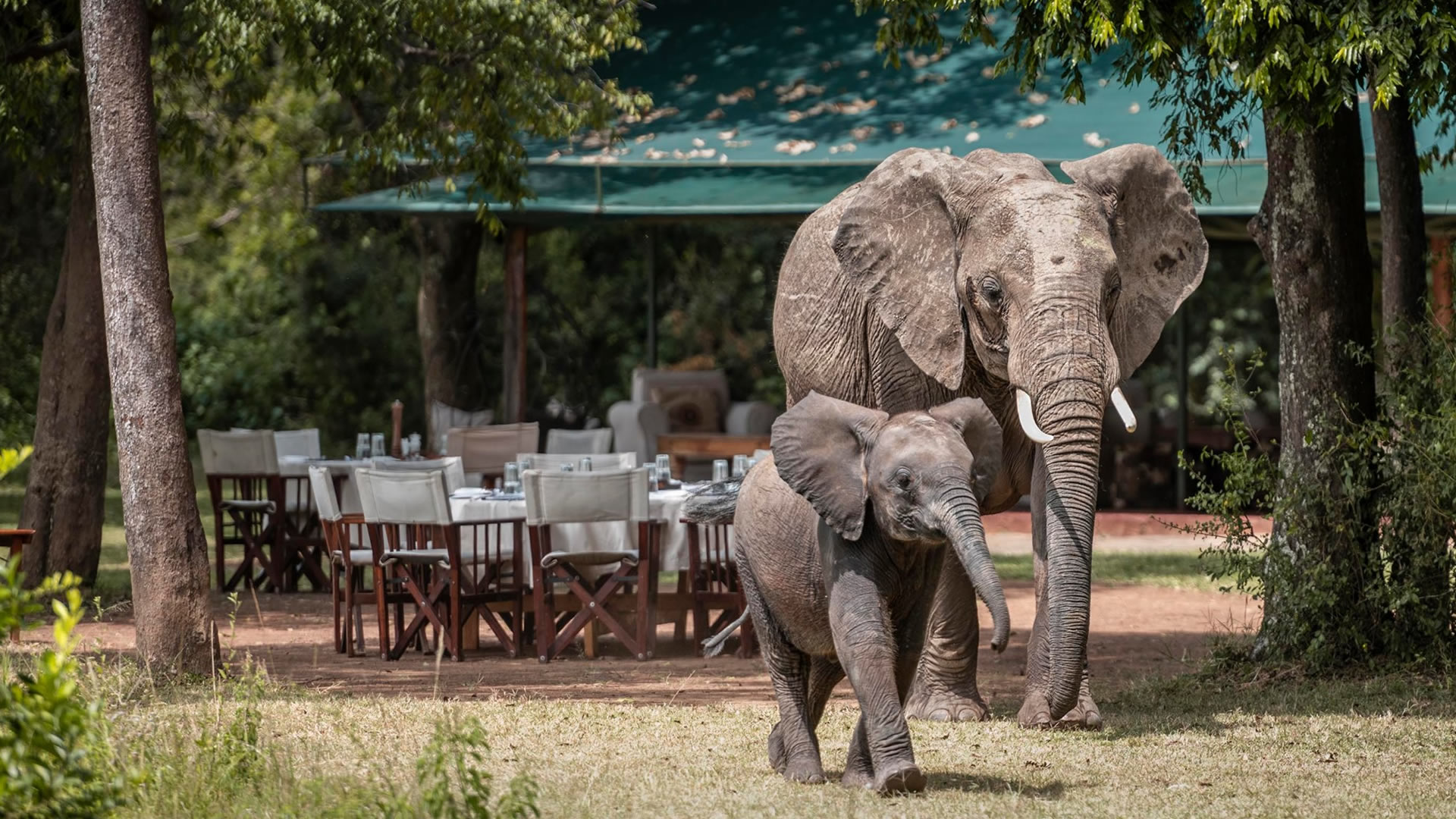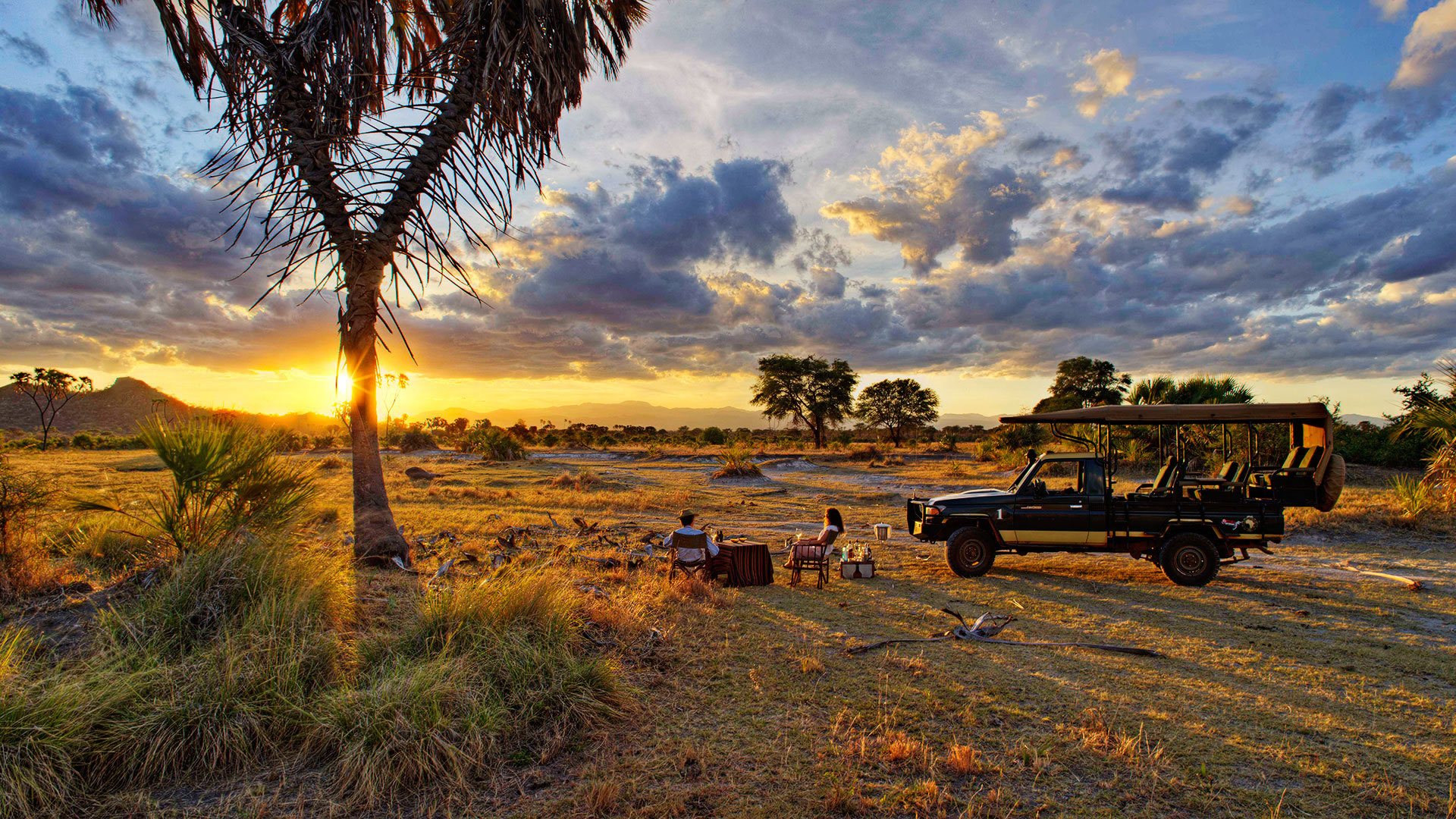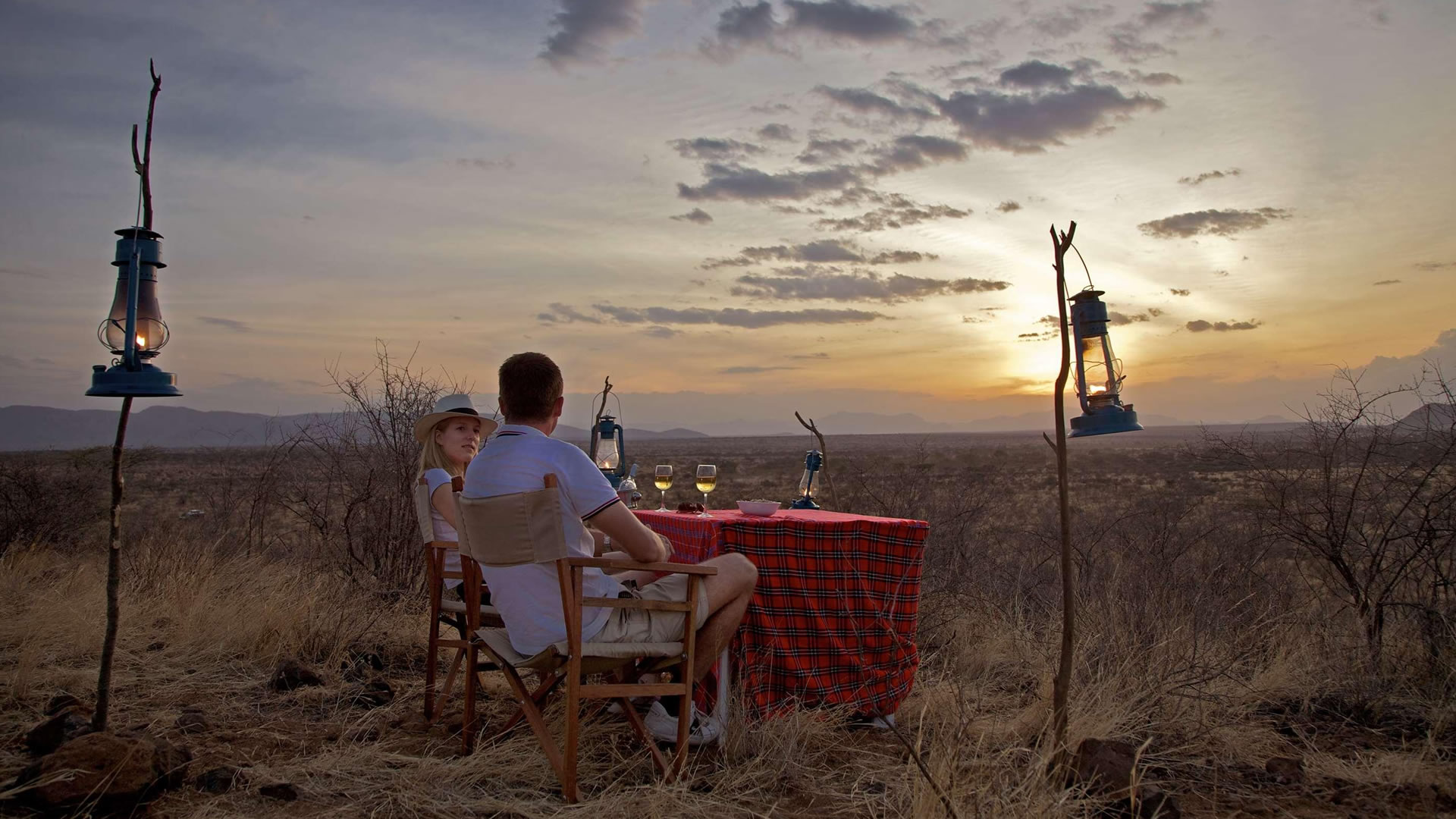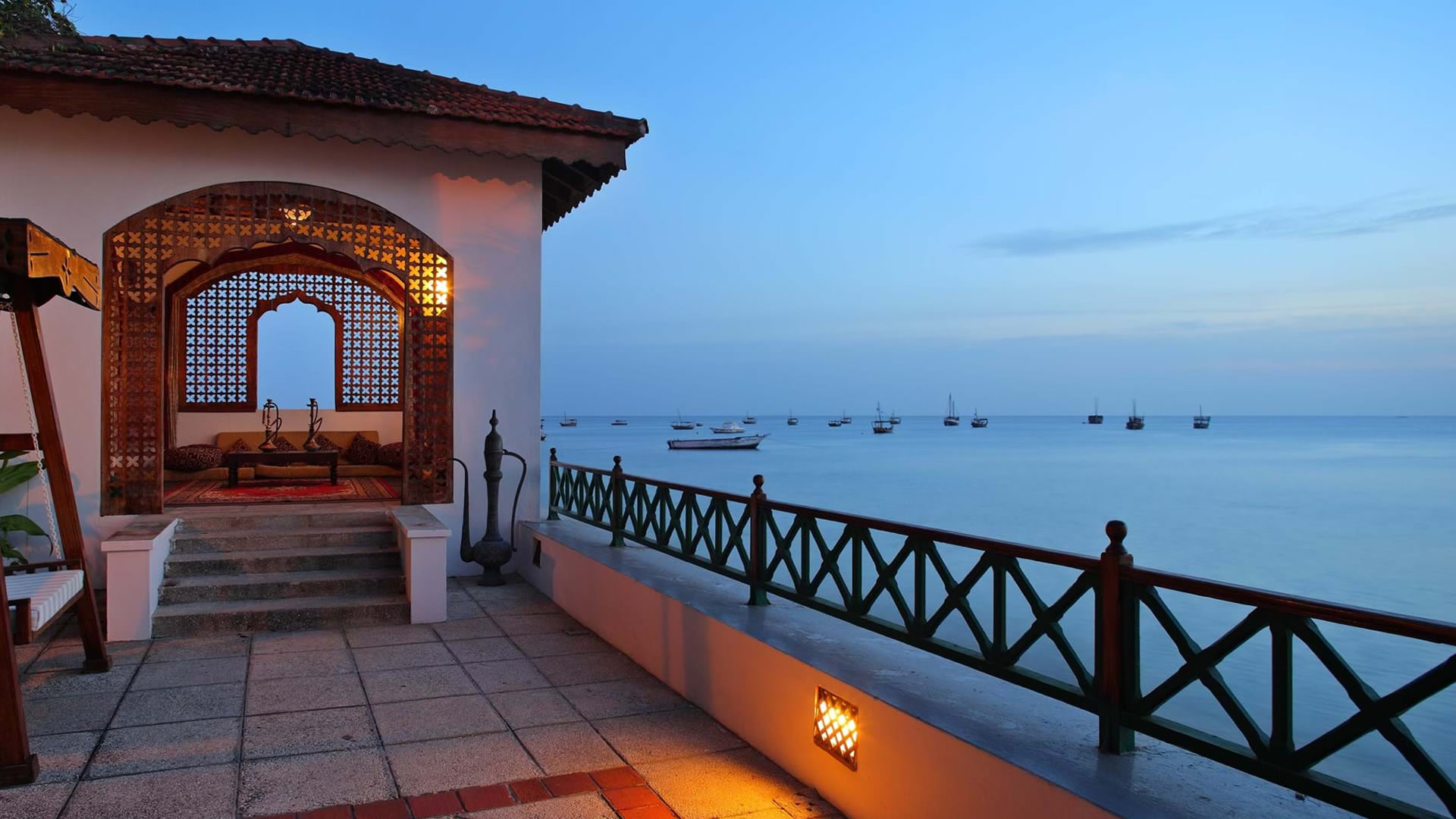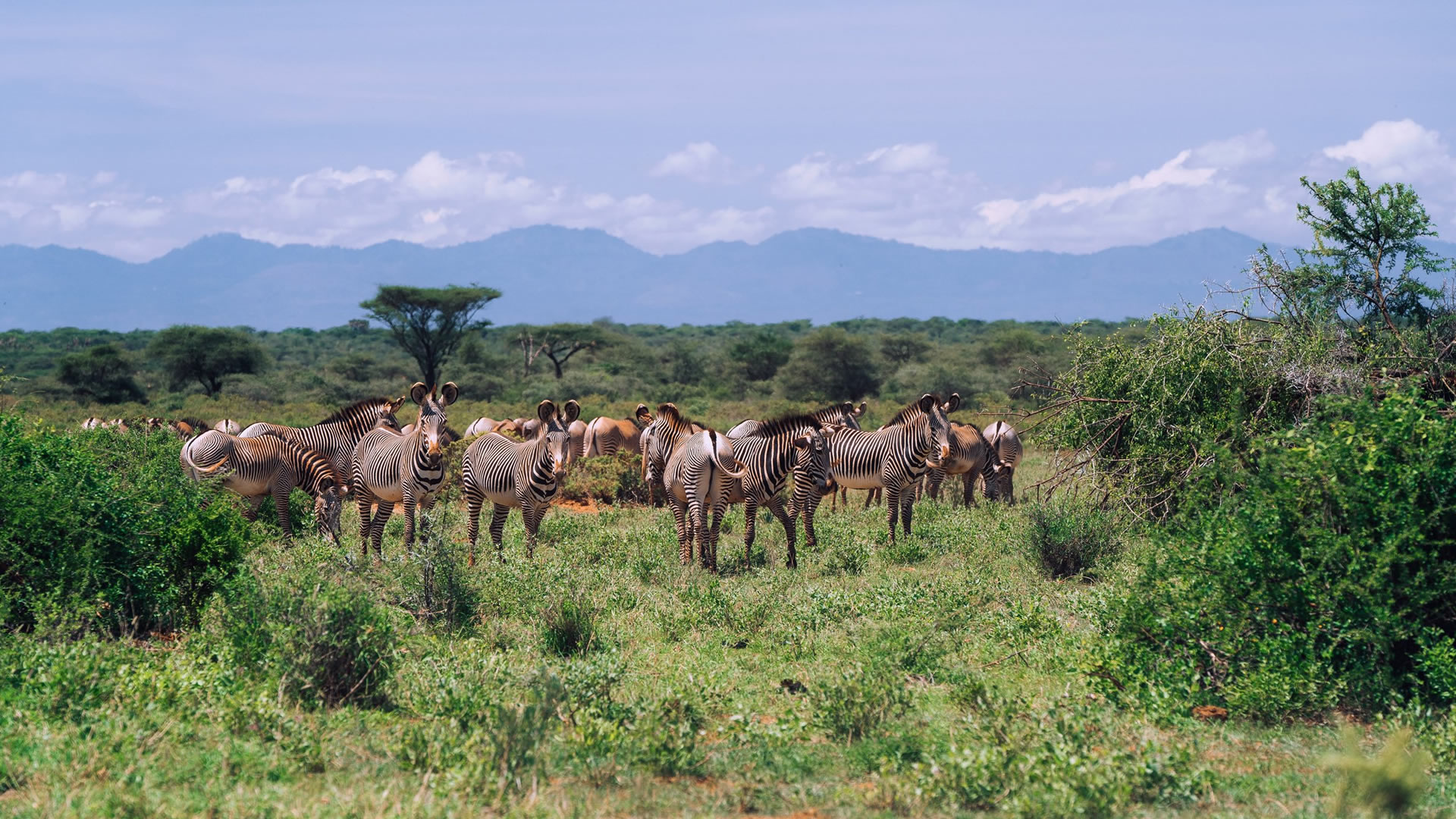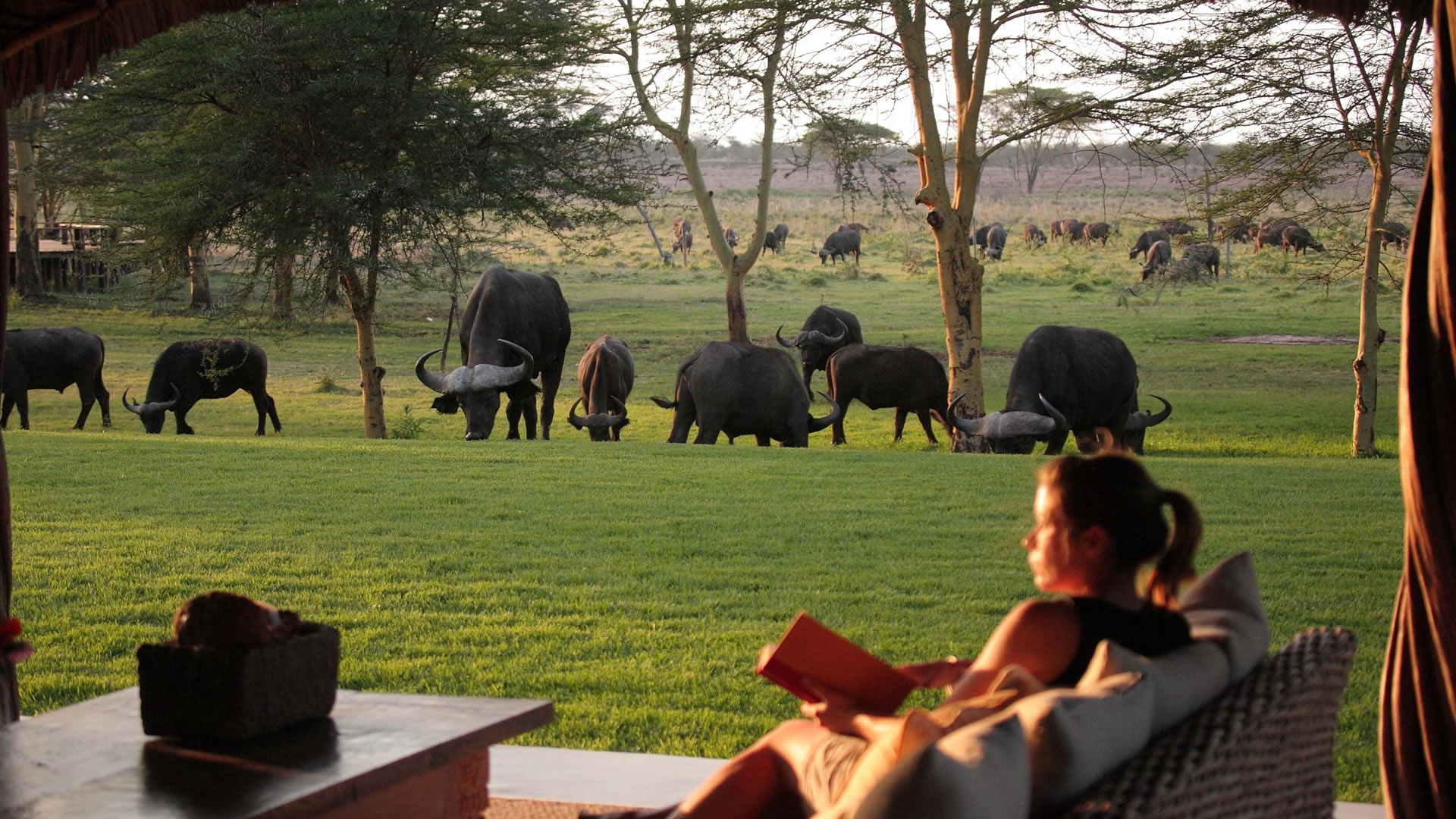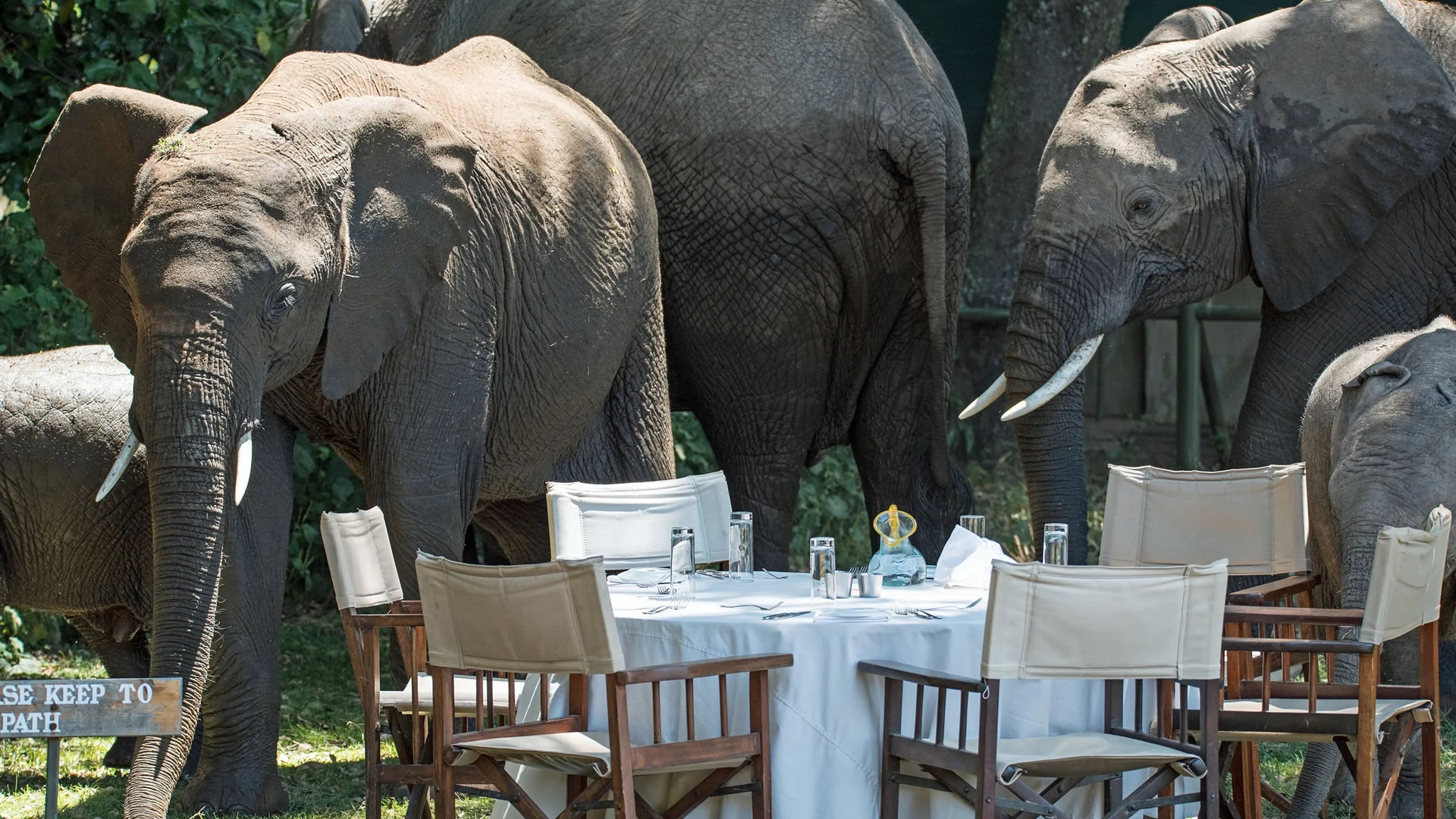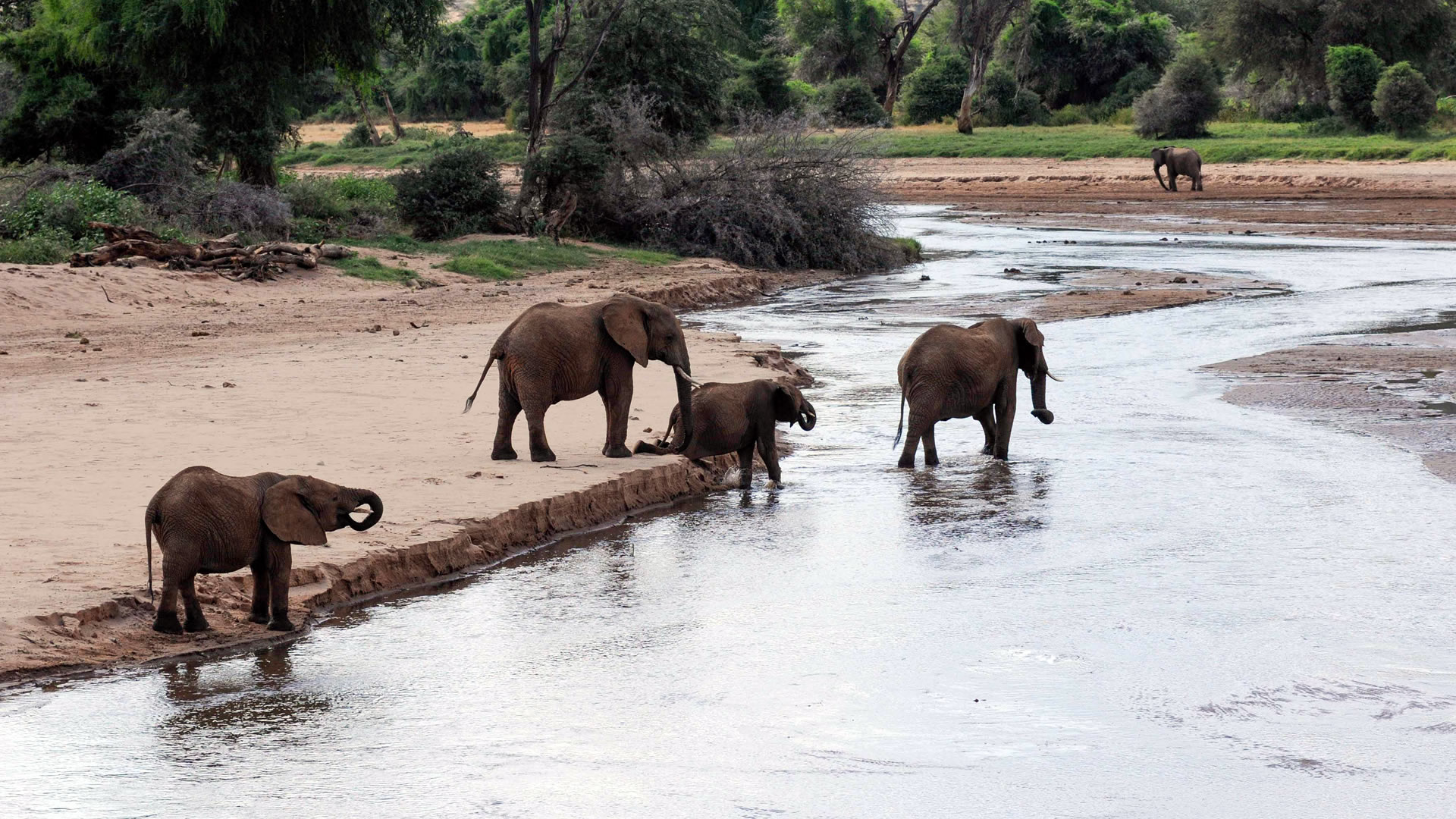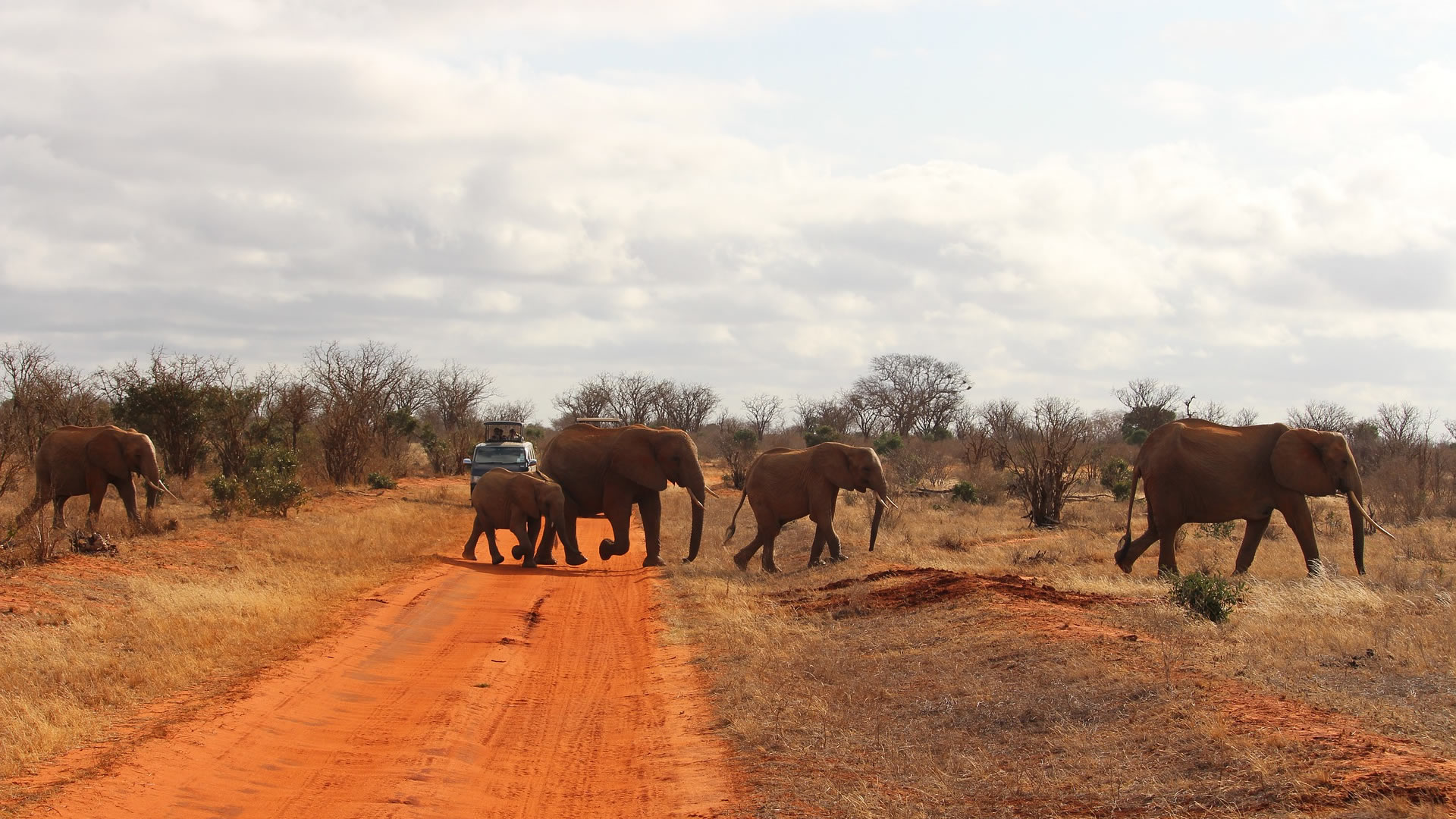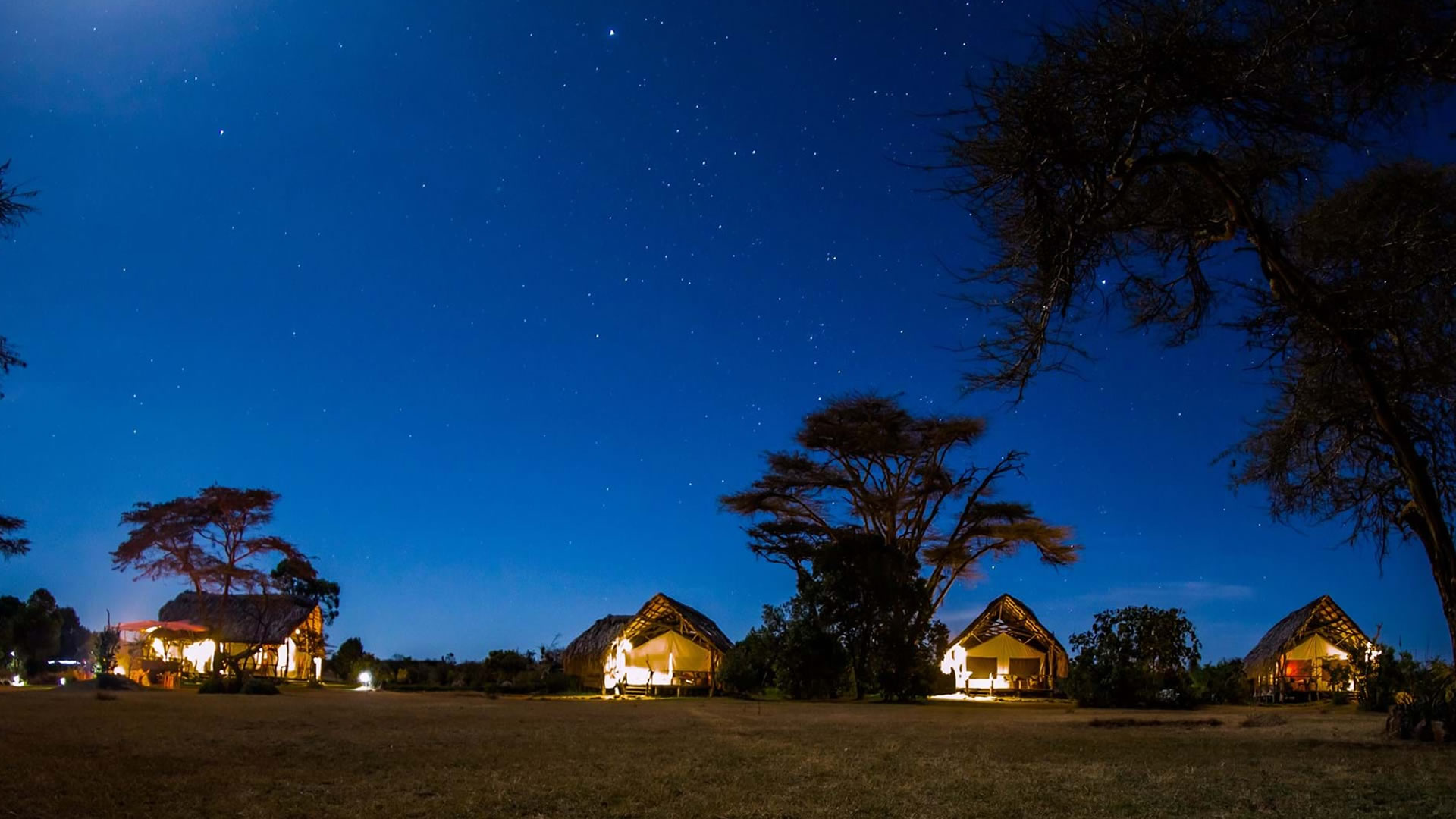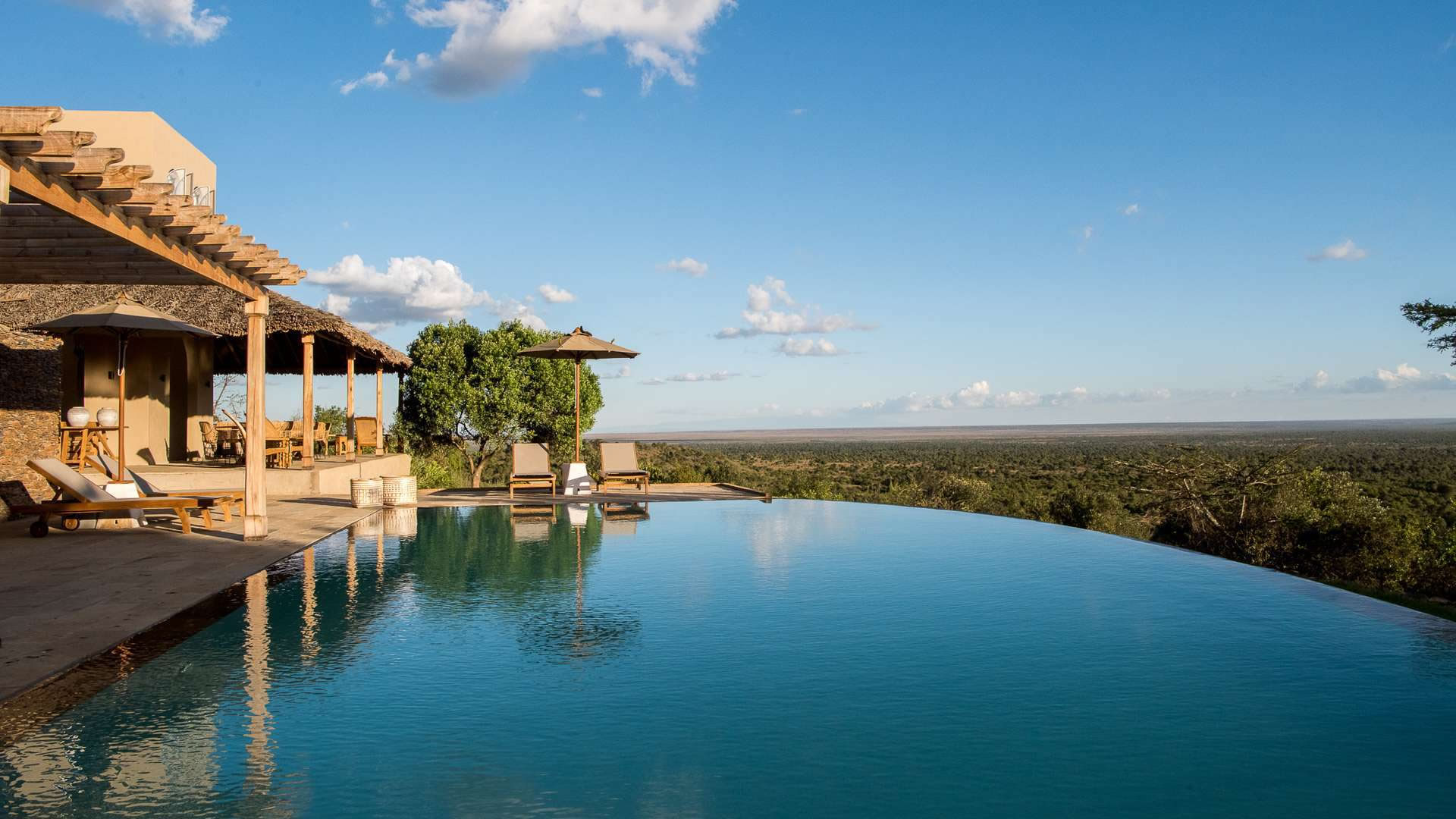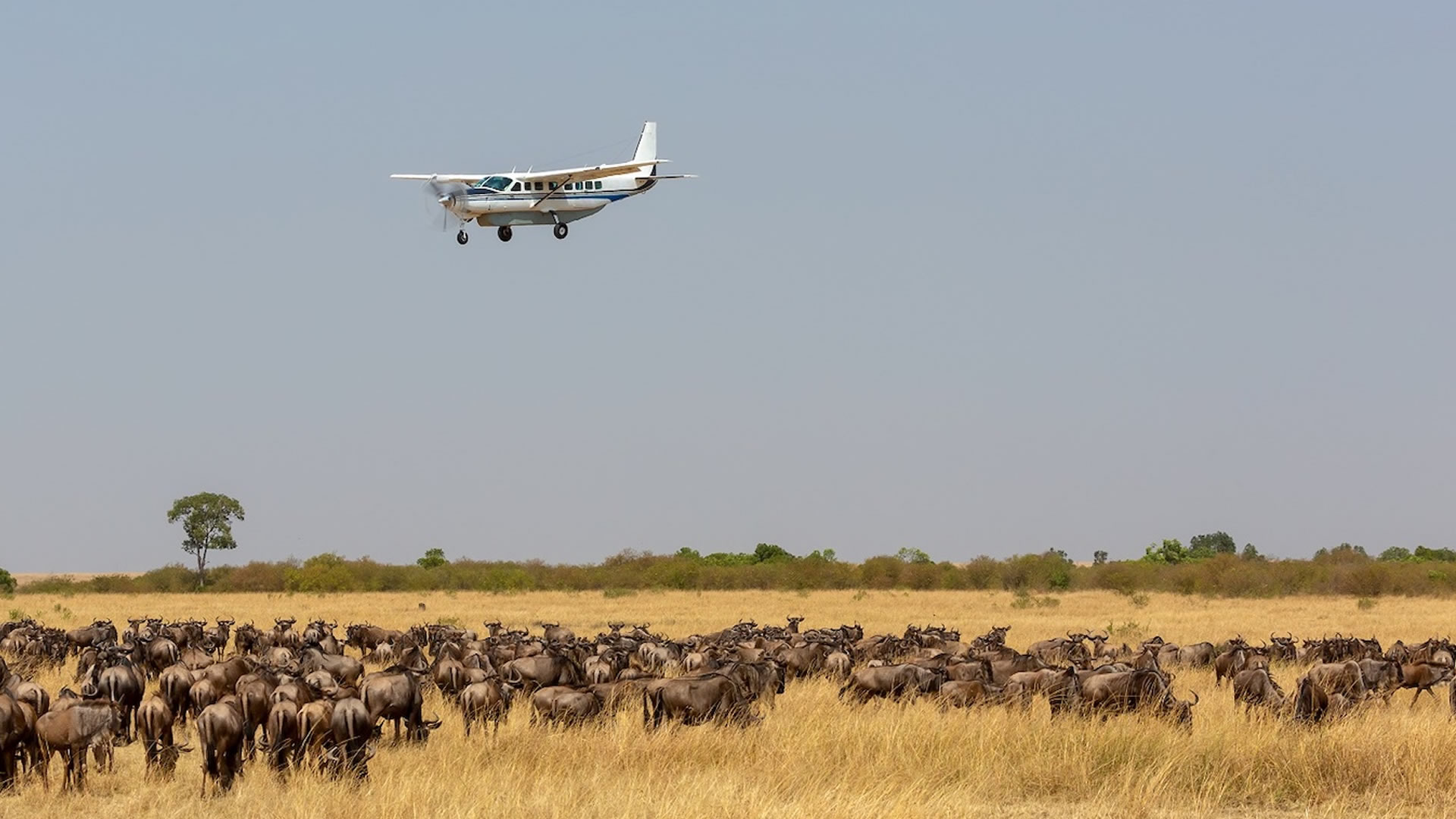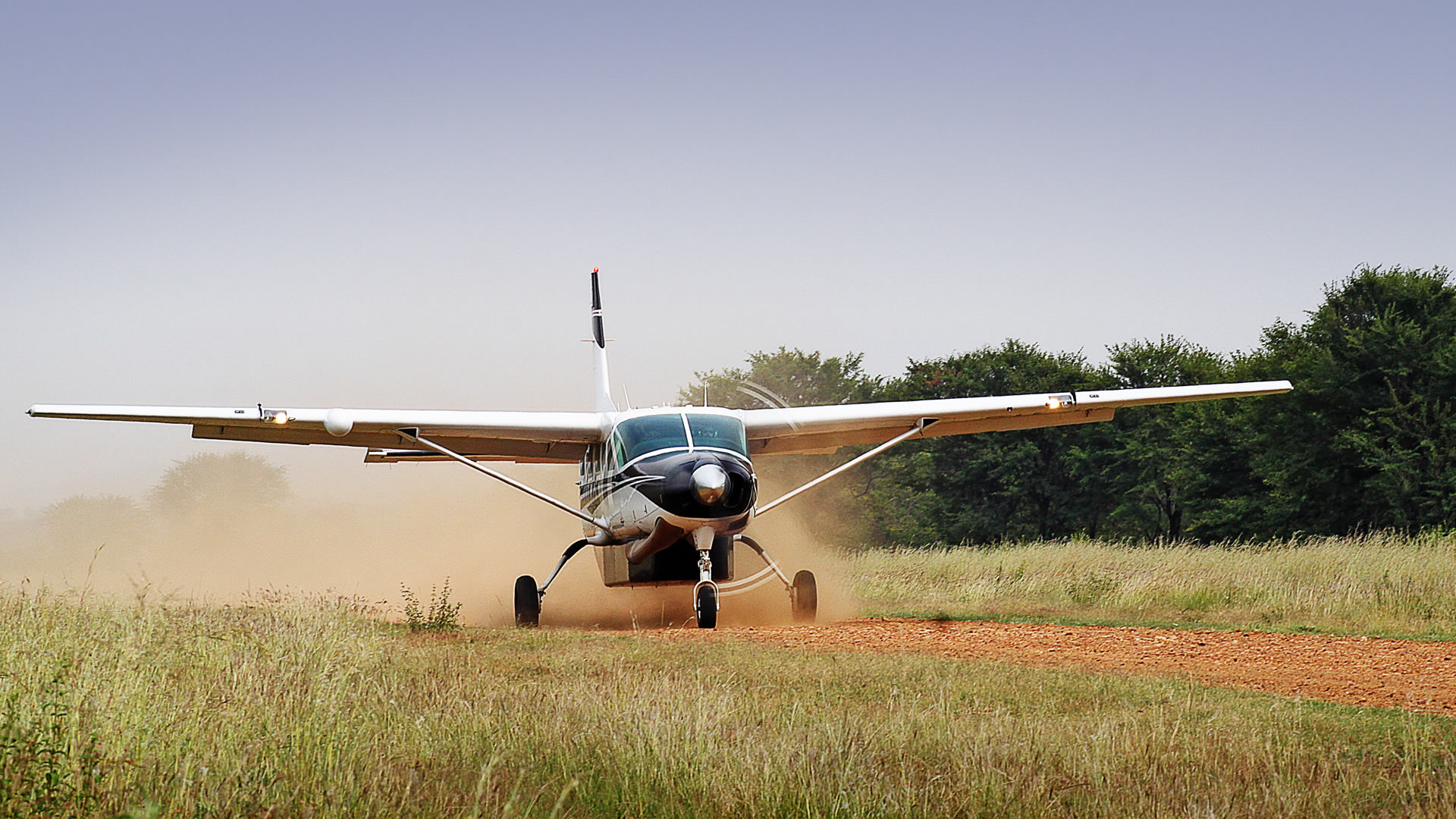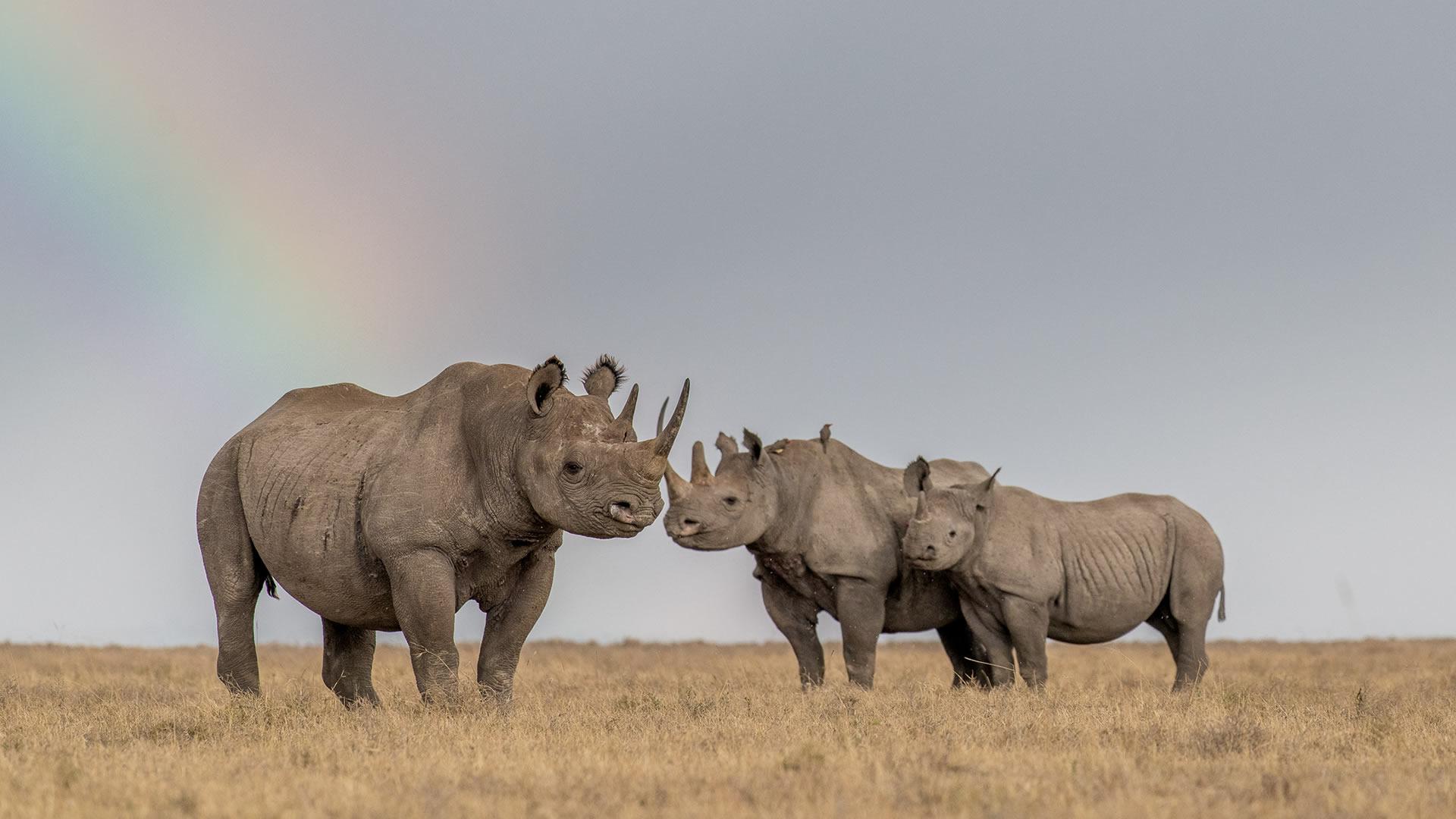[ Fig Tree Camp | Kilima Safari Camp ]
At a glance
FIGTREE CAMP
Fig Tree Camp sets a visionary standard for luxury adventures in the heart of the Masai Mara.
It is the perfect destination for travelers seeking an African safari experience infused with the continent’s vibrant spirit and surrounded
by unmatched comfort. The camp features meticulously designed interiors that harmoniously blend diverse textures, innovative and
practical aesthetics, and a modern interpretation of the essential elements of a romantic, luxurious tented safari.
Experiences
Game drive & local Masai attraction
Offering exceptional game-viewing opportunities in the vast savannas of Masai Mara, the camp is strategically situated along the bank
of Talek River, amidst the Great Wildebeest Migration route. Discover Fig Tree Camp, where every moment is crafted to immerse you
in the essence of the Masai Mara. Our offerings include guided game walks that bring you close to the wildlife, enhancing your safari
experience. Indulge in exhilarating game drives, bush black-tie dinners, and champagne breakfasts on the plains. Don't miss the
opportunity to soar above the savanna with Adventures Aloft Balloon Safaris, departing daily from our camp.
KILIMA SAFARI CAMP
Discover unparalleled luxury amidst Amboseli's wild beauty, with Mount Kilimanjaro as your backdrop at Kilima Safari Camp
Nestled alongside the Kimana Gate Park entrance in Amboseli National Park, Kilima Safari Camp occupies a sprawling 420-acre site
with unparalleled vistas of Mount Kilimanjaro.
Renowned for its thriving elephant population, the camp location promises extraordinary wildlife encounters. Guests indulge in superb
game viewing from their tents, which overlook natural water pools frequented by iconic African species. Every public space and guest
accommodation is meticulously oriented towards the majestic silhouette of Mount Kilimanjaro, ensuring an unforgettable blend of
luxury and natural beauty in the heart of the Kenyan wilderness
Detailed Kenya Safari Itinerary
Day 1: Masai Mara National Reserve, Fig Tree Camp (Fullboard)
In the afternoon there would game viewing drive from 15:30 until at 18:30 when you would go back to the camp for refreshments and dinner from 19:30 then overnight.
- Bush Dinners & Bush Breakfast
- Garden Swimming Pool
- Lion Rock Sundowners
- Game Drives
- Nature Walks
- Bird Watching Walks
- Cultural Perfomances
- Massages & Spa Treatments
- Weddings
- Honeymoons
Fig Tree Camp sets a visionary standard for luxury adventures in the heart of the Masai Mara.
It is the perfect destination for travelers seeking an African safari experience infused with the continent’s vibrant spirit and surrounded
by unmatched comfort. The camp features meticulously designed interiors that harmoniously blend diverse textures, innovative and
practical aesthetics, and a modern interpretation of the essential elements of a romantic, luxurious tented safari.
The Masai Mara National Reserve is one of Africa’s most famous parks. The wildlife viewing is superb throughout the year. The grassy plains and regular rainfall supports a huge population of herbivores, in turn attracting many predators. All three big cats are relatively easy to see. The yearly wildebeest migration coming through the park is one of the world’s most amazing wildlife spectacles.
The Serengeti-Mara ecosystem is home to the annual wildebeest migration where 2.5 million wildebeest, zebra and gazelles follow the rains in search of new grass. They make their way from the Serengeti to the Masai Mara somewhere around July and August, and usually arrive in September. The crossing of the Mara River along the way is one of the highlights of this spectacular event. They slowly head back into Tanzania around October.
Full List of Mammals found in Masai Mara National Reserve
- Aard-wolf
- African Bufallo
- African Civet
- African Dormouse
- African Elephant
- African Hare
- African Palm Civet
- African Wild Cat
- Angola Free-tailed Bat
- Ant Bear
- Approach the race robertsi
- Banana Bat or African Pipi
- Banded Mongoose
- Bat-eared Fox
- Black and White Colobus
- Black Rhinoceros
- Black-backed or Silver-backed
- Lion
- Black-faced Vervet Monkey
- Blue Duiker
- Leopard
- Hollow-faced Bat
- Side-striped Jackal
- Ant Bear
- False Vampire Bat
- Bat-eared Fox
- Tree Hyrax
- Yellow-winged Bat
- Zorilla
- Rock Hyrax
- Lander’s Horseshoe Bat
- Ratel or Honey Badger
- African Elephant
- Lesser Leaf-nosed Bat
- Clawless Otter
- Black Rhinoceros
- Giant Leaf-nosed Bat Recorded
- African Civet
- Grevy’s Zebra
- From Galana River
- Neumann’s or Small-spotted
- African Trident Bat Recorded
- Genet
- Burchell’s or Common Zebra
- From Kilaguni Lodge
- Bush or Large-spotted Genet
- Warthog
- Banana Bat or African
- African Palm Civet
- Masai Giraffe
- Pipistrelle
- Marsh Mongoose
- Coke’s Hartebeest or Kongoni
- Yellow-bellied Bat
- Dwarf Mongoose
- Hunter’s Hartebeest or Hirola
- Angola Free-tailed Bat
- Large Grey Mongoose
- White-bellied Free-tailed
- Bat
- Slender or Black-tipped Mongoose
- Red Duiker
- Flat-headed Free-tailed Bat
- White-tailed Mongoose
- Blue Duiker
- Greater Galago
- Banded Mongoose
- Bush Duiker
- Bush Baby
- Aard-wolf
- Klipspringer
- Black-faced Vervet Monkey
- Spotted Hyaena
- Suni
- Steinbok
- Bushbuck
- Unstriped Ground Squirrel
- Kirk’s Dik-dik
- Lesser Kudu
- Bush Squirrel
- Common Waterbuck
- Eland
- East African Red Squirrel
- Bohor Reedbuck
- African Buffalo
- Spring Hare
- Impala
- African Hare
- African Dormouse
- Grant’s Gazelle
- Cane Rat
- Giant Rat
- Gerenuk
- Porcupine
- Kenya Mole Rat
- Fringe-eared Oryx
- Striped Ground Squirrel
- Naked Mole Rat
The Masai Mara National Reserve isn’t one of Kenya’s birding hotspots. However, with more than 500 bird species recorded, this isn’t a bad place to mark off a lot of Kenya’s savannah species from your bird list. The park is particularly rich in raptors with 57 species present. Bateleurs can often be seen soaring above the grassy plains and predator kills are a good place to find up to six species of vultures scavenging. Migratory birds are present from November to April.
- Abdim’s Stork
- Abyssinian Hill Babbler Occurs
- Abyssinian Scimitar-bill
- African Black Duck Recorded
- African Black Kite
- African Cuckoo
- African Darter
- African Finfoot
- African Fire Finch
- African Fish Eagle
- African Golden Oriole
- African Goshawk
- African Hawk Eagle
- African Hobby Recorded from
- African Hoopoe
- African Jacana
- African Kestrel
- African Marsh Harrier Rare
- African Marsh Owl
- African Moustached Warbler
- African Penduline Tit
- African Pied Wagtail
- African Rock Martin
- African Sand Martin
- African Scops Owl
- African Snipe
- African Spoonbill Uncommon
- African Wood Owl
- along Tsavo and Galana Rivers
- Amethyst Sunbird
- amongst flocks of migrating
- an Barn Owl
- And March
- Angola Swallow
- Anteater Chat Chyulu Hills
- Arrow-marked Babbler
- as spring passage migrant
- Ashy Cisticola
- Ashy Flycatcher
- Augur Buzzard
- Avocet
- Ayres’ Hawk Eagle
- Banded Martin
- Banded Tit-warbler
- Bare-eyed Thrush
- Barred Owlet
- Barred Warbler
- Bat Hawk
- Bateleur
- Bearded Woodpecker
- Beautiful Sunbird
- Black and White Cuckoo
- Black Crake
- Black Cuckoo
- Black Cuckoo Shrike
- Black Heron Lake Jipe
- Black Rough-wing Swallow
- Black-backed Puff-back
- Black-bellied Bustard
- Black-breasted Apalis
- Black-breasted Glossy Starling
- Blackcap Bush Tchagra
- Blackcap Warbler
- Black-capped Social Weaver
- Black-cheeked Waxbill
- Black-chested Harrier Eagle
- Black-faced Sandgrouse
- Blackhead Plover
- Black-headed Heron
- Black-headed Oriole
- Black-headed Tchagra
- Black-necked Weaver
- Black-shouldered Kite
- Blacksmith Plover
- Black-throated Wattle-eye
- Black-winged Stilt
- Block-collared Barbet
- Blue-capped Cordon-bleu
- Blue-cheeked Bee-eater
- Blue-eared Glossy Starling
- Blue-headed Wagtail and races
- Blue-naped Mousebird
- Boehm’s Spinetail Frequents
- Booted Eagle Rare winter
- Brimstone Canary
- Broad-billed Roller
- Bronze Mannikin
- Bronze-naped Pigeon
- Bronze-winged Courser
- Bronzy Sunbird
- Brown Harrier Eagle
- Brown Parrot
- Brown Woodland Warbler
- Brown-breasted Barbet
- Brown-headed Tchagra
- Brown-hooded Kingfisher
- Brown-throated Barbet
- Buffalo Weaver
- Buff-backed Heron or
- Buff-bellied Warbler
- Buff-crested Bustard
- Bunting
- Button Quail
- Cape Quail
- Capped Wheatear
- Cardinal Quelea
- Cardinal Woodpecker
- Carmine Bee-eater
- Caspian Plover Winter visitor
- Cattle Egret
- Chestnut Sparrow
- Chestnut Weaver
- Chestnut-backed Sparrow Lark
- Chestnut-bellied Sandgrouse
- Chin-spot Flycatcher
- Cliff Chat
- Collared Sunbird
- Common Sandpiper
- Coqui Francolin
- Crested Francolin
- Croaking Cisticola
- Crombec
- Crowned Crane
- Crowned Hawk Eagle Occurs
- Crowned Hornbill
- Crowned Plover
- Cuckoo Falcon Uncommon
- Curlew Sandpiper
- curs in forest on Chyulu Hills
- Cut-throat
- D’Arnaud’s Barbet
- Didric Cuckoo
- Donaldson-Smith’s Nightjar
- Drongo
- Dusky Flycatcher
- Dusky Nightjar
- Dwarf Bittern
- Eastern Bearded Scrub Robin
- Eastern Double-collared
- Eastern Red-footed Falcon Very
- Egyptian Goose
- Egyptian Vulture
- Emerald Cuckoo
- Emerald-spotted Wood Dove
- Ethiopian Swallow
- European Bee-eater
- European Black Kite
- European Black Stork
- European Common Snipe
- European Common Wheatear
- European Corn Crake Passage
- European Cuckoo
- European Golden Oriole
- European Hobby Occurs mainly
- European Hoopoe
- European Kestrel
- European Marsh Harrier
- European Marsh Warbler
- European Nightingale
- European Nightjar
- European Pintail
- European Rock Thrush
- European Roller
- European Sand Martin
- European Sedge Warbler
- European Shoveler
- European Spotted Flycatcher
- European Swallow
- European Whinchat
- European White Wagtail
- European White-throat
- European Willow Warbler
- Fan-tailed Raven
- Fan-tailed Warbler
- Fan-tailed Widow-bird
- Fawn-coloured Lark
- Fire-fronted Bishop
- Fiscal Shrike
- Fischer’s Greenbul
- Fischer’s Sparrow Lark
- Fischer’s Starling
- Fischer’s Straw-tailed Whydah
- Flappet Lark
- Forest and in riverine forest
- forest near Voi
- Four-coloured Bush Shrike
- Freckled Nightjar
- Frequents open plains.
- from the Galana River
- from Tsavo and Athi Rivers
- Fulvous Tree Duck
- Gabar Goshawk
- Galana River
- Galena River, but not
- Garden Warbler
- Garganey Teal
- Giant Kingfisher
- Glossy Ibis Rare visitor
- Golden Palm Weaver
- Golden Pipit
- Golden Weaver
- Golden-breasted Bunting
- Golden-breasted Starling
- Golden-rumped Tinkerbird
- Golden-tailed Woodpecker
- Goliath Heron
- Grasshopper Buzzard Common
- Great Reed Warbler Uncom-
- Great Snipe
- Great Sparrow Hawk
- Great White Egret
- Greater Honeyguide
- Greater or White-eyed Kestrel
- Greater Swamp Warbler
- Great-spotted Cuckoo
- Green Pigeon
- Green Sandpiper
- Green Wood Hoopoe
- Green-backed Heron Occurs
- Greenshank
- Green-winged Pytilia
- Grey Cuckoo Shrike Chyulu
- Grey Flycatcher
- Grey Heron
- Grey Hornbill
- Grey Kestrel Uncommon
- Grey Tit
- Grey Woodpecker
- Grey Wren Warbler
- Grey-backed Camaroptera
- Grey-backed Fiscal
- Grey-capped Warbler
- Grey-headed Bush Shrike
- Grey-headed Kingfisher
- Grey-headed Silverbill
- Grey-headed Social Weaver
- Grey-rumped Swallow
- Grosbeak Weaver
- Ground Hornbill
- Hadada Ibis
- Half-collared Kingfisher Rare
- Hamerkop
- Harlequin Quail
- Harrier Hawk
- Hartlaub’s Bustard
- Hartlaub’s Turaco Occurs
- Helmeted Guinea-fowl
- Heuglin’s Courser
- Hildebrandt’s Starling
- Hills forest
- Holub’s Golden Weaver
- Honey Buzzard Uncommon
- Hooded Vulture
- Hottentot Teal
- Hunter’s Sunbird
- Indigo-bird
- Inhabits acacia trees near rivers
- Isabelline Wheatear
- Issabeline Wheatear
- Jackson’s Bustard Rare
- Jameson’s Fire Finch
- Kaffir Rail Rarely seen
- Kenya Crested Guinea-fowl
- Kenya Grosbeak Canary
- Kenya Violet-backed Sunbird
- Kittlitz’s Plover
- Klaas’ Cuckoo
- Knob-billed Duck
- Kori Bustard
- Lammergeyer Rare visitor
- Lanner
- Laughing Dove
- Layard’s Black-headed Weaver
- Lesser Grey Shrike
- Lesser Honeyguide
- Lesser Kestrel
- Lesser Kestrels in spring
- Lesser Spotted Eagle Rare
- Levaillant’s Cuckoo
- Lilac-breasted Roller
- Little Bee-eater
- Little Bittern
- Little Egret
- Little Grebe
- Little Grey Flycatcher Re-
- Little Purple-banded Sunbird
- Little Ringed Plover
- Little Sparrow Hawk
- Little Stint
- Little Swift
- Lizard Buzzard
- Long-billed Pipit
- Long-crested Eagle
- Long-tailed Cormorant
- Long-tailed Fiscal
- Long-tailed Nightjar
- Madagascar Bee-eater
- Madagascar Squacco Heron
- Malachite Kingfisher
- Marabou Stork
- Mariqua Sunbird
- Marsh Sandpiper
- Martial Eagle
- Masai Ostrich
- Masked Weaver
- Migrant seldom seen
- mon passage migrant
- Montagu’s Harrier
- Moorhen
- Morning Warbler Frequents
- Mosque Swallow
- Mottled Swift
- Mottled-throated Spinetail
- Mourning Dove
- Mouse-coloured Penduline Tit
- Namaqua Dove
- Narina’s Trogon In Chyulu
- Near Galana River
- Nicator Occurs in acacia
- Night Heron
- north of Galana River
- north of the Galana River
- Northern Brownbul
- Northern Brubru
- Northern Pied Babbler
- Northern White-tailed Lark
- Nubian Nightjar
- Nubian Woodpecker
- Nyanza Swift
- Occur on rocky hills north of
- occurs along rivers
- Occurs in dry bush country
- occurs in forests and well-
- Olive Pigeon
- Olive Sunbird
- Olive Thrush
- Olive-tree Warbler
- On rivers
- On southern border
- Open-bill Stork
- Orange-bellied Parrot
- Osprey Rare visitor
- Ovampo Sparrow Hawk Un-
- Painted Snipe
- Pale Chanting Goshawk
- Pale Flycatcher
- Pallid Harrier
- Palm Swift
- palm Thickets
- Palm-nut Vulture
- Pangani Longclaw
- Paradise Flycatcher
- Paradise Whydah
- Parasitic Weaver
- Parrot-billed Sparrow
- Pearl-spotted Owlet
- Pectoral-patch Cisticola
- Pel’s Fishing Owl Not yet re-
- Peregrine Uncommon
- Peter’s Twin-spot Occurs in
- Pied Crow
- Pied Kingfisher
- Pied Wheatear
- Pink-backed Pelicans
- Pink-breasted Lark
- Pin-tailed Whydah
- Plain Nightjar
- Pratincole
- Probably occurs at Lake Jipe
- Purple Grenadier
- Purple Heron Recorded from
- Pygmy Falcon
- Pygmy Goose Lake Jipe
- Pygmy Kingfisher
- Pygmy Puff-back Flycatcher
- Quail Finch
- Rare visitor
- Rare winter visitor
- Rattling Cisticola
- Recorded from Mzima Springs
- recorded in the Voi area
- Recorded near Voi
- Red and Yellow Barbet
- Red Bishop
- Red-backed Scrub Robin
- Red-backed Shrike
- Red-billed Duck
- Red-billed Fire Finch
- Red-billed Hornbill
- Red-billed Oxpecker
- Red-billed Quelea
- Red-capped Lark
- Red-capped Robin Chat
- Red-cheeked Cordon-bleu
- Red-chested Cuckoo
- Red-collared Widow-bird
- Red-eyed Dove
- Red-faced Apalis
- Red-fronted Tinkerbird
- Red-headed Weaver
- Red-knobbed Coot Uncommon
- Red-naped Bush Shrike
- Red-necked Falcon Occurs
- Red-rumped Swallow
- Red-tailed Shrike
- Red-throated Pipit Uncommon
- Redwing Bush Lark
- Red-wing Starling
- Reichenow’s Weaver
- Retz’s Red-billed Shrike
- Richard’s Pipit
- Ringed Plover
- Ring-necked Dove
- River Warbler
- Robin Chat
- Rocky hills near Mtito Andei
- Rosy-breasted Longclaw Un-
- Rosy-patched Shrike
- Ruff
- Rufous Chatterer
- Rufous Sparrow
- Rufous-backed Mannikin
- Rufous-crowned Roller
- Ruppell’s Long-tailed Starling
- Ruppell’s Vulture
- Sacred Ibis
- Saddle-bill Stork
- Scaly Chatterer Occurs mainly
- Scaly Francolin Occurs on
- Scaly-throated Honeyguide
- Scarlet-chested Sunbird
- Scimitar-bill
- Secretary Bird
- Senegal Hoopoe Occurs mainly
- Senegal Plover
- Shelley’s (Greywing) Francolin
- Shelley’s Starling
- Shikra
- Silverbill
- Silverbird
- Silvery-cheeked Hornbill
- Singing Bush Lark
- Singing Cisticola
- Slate-coloured Boubou
- slopes of hills
- Smaller Black-bellied Sunbird
- Somali Golden-breasted Bunting
- Somali Ostrich
- Sooty Falcon Recorded during
- South African Black Flycat
- Speckled Mousebird
- Speckled Pigeon
- Speckle-fronted Weaver
- Spectacled Weaver
- Spotted Eagle Owl
- Spotted Morning Warbler
- Spotted Stone Curlew
- Spotted-flanked Barbet
- spring passage migrant
- Spur-winged Goose
- Squacco Heron
- Steel-blue Whydah
- Steppe Buzzard Winter visitor
- Steppe Eagle
- Stone Partridge Reputed to
- Stonechat Chyulu Hills
- Stout Cisticola
- Straight-crested Helmet Shrike
- Streaky Seed-eater
- Striped Kingfisher
- Striped Pipit Frequents bushy
- Striped Swallow
- Sulphur-breasted Bush Shrike
- Sun- bird Chyulu Hills forest
- Superb Starling
- Swahili Sparrow
- Swallow
- Taita Falcon Rare: has been
- Taita Fiscal
- Tambourine Dove
- Tawny Eagle
- Tawny-flanked Prinia
- Temminck’s Courser
- The Tsavo and Galana rivers
- Three-banded Plover
- Three-streaked Tchagra
- Thrush Nightingale or Sprosser
- Tiny Cisticola
- Tree Pipit
- Tropical Boubou
- Trumpeter Hornbill
- Tsavo River
- Two-banded Courser
- Uncommon
- uncommon: a few to be seen
- Variable Sunbird
- Verreaux’s Eagle Owl
- Verreaux’s Eagle Rare
- Vicinity of baobab trees.
- Violet Wood Hoopoe Recorded
- Violet-backed Starling
- Violet-breasted Sunbird
- Violet-crested Turaco Rare
- Vitelline Masked Weaver
- Von der Decken’s Hornbill
- Vulturine Guinea-fowl
- Wahlberg’s Eagle
- Wahlberg’s Honeyguide
- Water Dikkop
- Wattled Starling
- Waxbill
- Well’s Wagtail Uncommon
- White Pelican
- White Stork
- White-backed Night Heron
- White-backed Vulture
- White-bellied Bustard
- White-bellied Canary
- White-bellied Go-away-bird
- White-breasted Tit
- White-browed Coucal
- White-browed Robin Chat
- White-browed Sparrow Weaver
- White-crowned Shrike
- White-eye Slaty Flycatcher
- White-faced Scops Owl
- White-faced Tree Duck
- White-headed Buffalo Weaver
- White-headed Mousebird
- White-headed Rough-wing
- White-naped Raven
- White-rumped Swift
- White-throated Bee-eater
- White-throated Robin Rare
- White-winged Scrub Robin
- White-winged Widow-bird
- Winding Cisticola
- winter visitor
- Winter visitor
- winter visitor and passage
- Wire-tailed Swallow
- Wood Ibis
- Wood Sandpiper
- wooded areas
- Wooly-necked Stork
- Yellow Bishop
- Yellow Flycatcher
- Yellow White-eye
- Yellow-bellied Eremomela
- Yellow-bellied Waxbill
- Yellow-billed Duck
- Yellow-billed Egret
- Yellow-billed Hornbill
- Yellow-billed Oxpecker
- Yellow-fronted Canary
- Yellow-necked Spurfowl
- Yellow-rumped Seed-eater
- Yellow-spotted Petronia
- Yellow-throated Longclaw
- Yellow-throated Sandgrouse
- Yellow-vented Bulbul
- Yellow-whiskered Greenbul
- Zanzibar Red Bishop
Days 2: Masai Mara National Reserve, Fig Tree Camp (Fullboard)
DAY 2. MASAI MARA NATIONAL RESERVE, FIG TREE CAMP, MEAL PLAN IS FULL BOARD
In this day you would wake up at 06:00 for tea or coffee and a snack then at 06:30 depart for an early morning game viewing drive until
time for full breakfast in the camp at 08:00 followed by a short rest in the camp then start another game viewing drive at 10:00 until at
13:00 time for refreshment and then lunch.
Alternatively you may do a full morning game viewing drive staring with tea or coffee and a snack at 06:00 and go for full morning
game viewing drive from 06:30 until time for lunch in the camp at 13:00.
In the afternoon there would another game viewing drive from 15:30 until at 18:30 when you would go back to the camp for
refreshments and dinner from 19:30 then overnight.
Day 3: Amboseli National Park, Kilima Safari Camp (Fullboard)
This day will be your last day in this reserve and so you would wake up for breakfast at 07:00 then thereafter be transferred to the
airstrip to catch up flight to Amboseli Natioanal Park where you would arrive 11:30 time for lunch in the lodge.
In the afternoon there would be a game viewing drive from 15:30 until at 18:30 when you would go back to the lodge for refreshments
and dinner from 19:30 then overnight.
- Vuria Bar Lounge
- Experiential Dining
- Afya Bora Spa
- Game Viewing Activities
- Walking Safaris
- Wildlife Talks
- Traditional Music & Dance
- Swimming
- Curio Shop
- Bush Meals + Sundowners
- Cultural Tourism
Its renowned for its thriving elephant population hence the camp location promises extraordinary wildlife encounters. Guests indulge in superb
game viewing from their tents, which overlook natural water pools frequented by iconic African species. Every public space and guest
accommodation is meticulously oriented towards the majestic silhouette of Mount Kilimanjaro, ensuring an unforgettable blend of
luxury and natural beauty in the heart of the Kenyan wilderness.
Amboseli National Park is often called the ‘Land of Giants’ – due to the impressive elephants here carrying massive tusks. The animals are set against breathtaking vistas of Mt Kilimanjaro, which makes an awesome backdrop to the small park. Aside from elephants, many plains animals are easy to spot. Fantastic photo opportunities are possible, and early mornings are best for clear views of Kilimanjaro.
Amboseli National Park is a good birding destination and more than 420 species have been recorded here. The swamps are great for water-associated birds such as egrets, herons, pelicans and crowned cranes. Large numbers of flamingos may be present in the Wet seasons (March to May and October to December). The grassland areas offer some interesting ground birds such as Hartlaub’s bustard and the localized Pangani longclaw. The acacia woodland holds some dry country specials such as steel-blue whydah, white-bellied go-away bird and the Von der Decken’s hornbill.
Day 4: Kenya Coast, Meal Plan is Breakfast Only
This would be your last day of this Africa safari and you would wake up at 06:00 for tea or coffee and a snack then at 06:30 depart for
an early morning game viewing drive until time for full breakfast in the camp at 08:00 followed by a short rest in the camp until time to
be transferred to the airstrip at 10:00 for your flight at 11:30 to Kenya Coast either to Malindi Airport. Diani Airport, or to Moi
International Airport.
End of the Kenya Safari

Easter & Christmas Surcharges
A surcharge would be charged per person per night on Good Friday, Saturday, Sunday, Easter Monday and on 24th 25th, 26th, 31st December and 1st January. The Surcharge would be confirmed at the time of booking for clarity purposes.
For optimal enjoyment of your Kenya Safari, we urge you to carry the following:
All weather firm shoe pair, short and dress to use during the day, trouser for use in the evenings with long sleeved shirt, sweater or jacket, hat, swimming costume, sunglass, camera, binocular, sun protection cream and insect repellent spray or cream.


